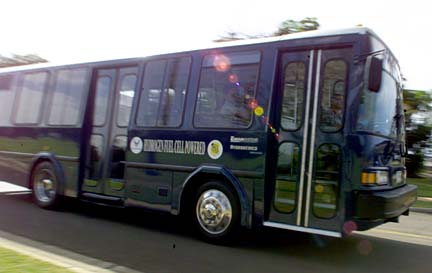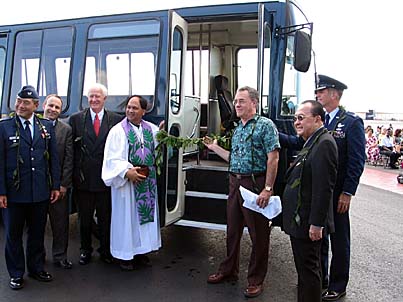
CINDY ELLEN RUSSELL / CRUSSELL@STARBULLETIN.COM
AF Fuel Cell 1, a hydrogen-powered bus, makes its rounds at Hickam Air Force Base. The $1 million alternative fuel bus is the first of its kind and will be used on base as a shuttle for base personnel, distinguished visitors and air crews.
Hickam bus
makes historyThe nation's first hydrogen-powered
vehicle acts as an Air Force shuttle
AF Fuel Cell-1 makes history in its rounds each day, picking up air crew members and other passengers at Hickam Air Force Base as the first vehicle in the country powered by hydrogen.
Rick Padua, Hickam's vehicle operations manager, said the only thing they may notice that sets AF Fuel Cell-1 apart from Hickam's fleet of 17 diesel buses is that it's quieter.
"The loudest thing is the air conditioner," said Padua.
Padua said it also seems that "the ride is smoother. It even takes the bumps a little better."
Beginning in March, the hydrogen-powered bus will be used to shuttle Air Force crews between hotels in Waikiki and Hickam.
The 24-passenger bus, operated by Hickam Air Force Base's 15th Logistics Readiness Division, is doing "ground breaking work," says Col. Raymond Torres, 15th Airlift Wing commander, and makes Hickam a "national evaluation center" because it is the first military base to receive such advanced technology.
The hydrogen fuel cell hybrid bus was developed by the Air Force, Enova Systems, Hydrogenics, and the state's High Technology Development Corp. President Bush in his State of the Union address last year proposed spending $1.2 billion over an unspecified period to speed the development of hydrogen-powered, zero-emission vehicles.
Col. David Nakayama, director of support and vehicle management at Robins Air Force Base in Georgia, at the dedication of the hydrogen-powered bus credited U.S. Sen. Daniel Inouye for obtaining federal funding for the project. He said the implications of the fuel cell vehicle is "staggering" for the military.
GREGG K. KAKESAKO / GKAKESAKO@STARBULLETIN.COM
Col. David Nakayama, left, Pierre Rivard, Carl Perry, the Rev. Kordell Kekoa, Philip Bossert, Col. Raymond Torres and U.S. Sen. Daniel Inouye participated in the blessing of the Air Force's first hydrogen fuel cell bus earlier this month.
As a career logistician, Nakayama said his challenge has always been supporting "bare bases" that the Air Force establishes in remote corners of the world and moving massive supplies of fossil fuels that they need to operate.
He said the development of alternative fuel vehicles is "just one milestone on the long journey of dual application" for both the military and civilian communities.
Tom Quinn, director of the Hawaii Center for Advanced Transportation Technologies, which initiated and managed the project, said that within four months of bringing Enova Systems and Hydrogenics together scientists were able to develop the fuel cell and battery hybrid electric propulsion system and use it to power the bus.
He explained that that fuel cell is a chemical device where hydrogen and oxygen are mixed to generate electricity, which powers the vehicle and recharges the backup battery.
"There are zero emissions," Quinn said, "and the only live product is water vapor."
The bus is capable of going up to 45 mph. He estimated that the project cost about $1 million.
Inouye noted that although it's taken more than a decade and at least $20 million to develop this alternative to cars dependent on fossil fuels, he believes the effort is worth it.
The Hawaii Democrat said that with the price of fossil fuels rising and falling, the cost of developing an alternative is "a bargain."
"This is politically correct," Inouye said. "It is environmentally correct. It is economically correct and it is security-wise correct."
Quinn said the new Air Force bus will undergo a year of study while it is being used at Hickam to help the Air Force determine future use.
He said his agency, part of the state High Technology Development Corp., will receive an additional $2.4 million to expand the program at Hickam to include the development of a hydrogen generation, storage and dispensing station and advanced propulsions systems and energy storage systems for ground support equipment.
"Right now the bus is refueled by a 40-foot trailer," Quinn said, "which has tanks that hold up to 160,000 cubic feet of hydrogen gas -- about a 40-day supply."
Quinn said when his agency was formed in 1993 and was known as the Hawaii Electric Vehicle Demonstration Project, "We had a mission: we wanted to take the lead not just in Hawaii, but in the country."
Padua said that using a combination of its hydrogen cell and batteries the new bus can be operated between six to seven hours before it needs to be charged.
"That is a lot compared to another bus we have which depends on electric power and needs to be charged every 2 1/2 hours," Padua said.
Other projects now in the works involve hybrid electric tow tractor and aircraft loader as well research into lithium ion battery technology.

